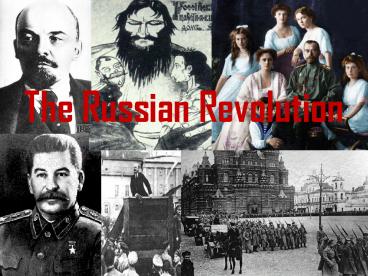The Russian Revolution - PowerPoint PPT Presentation
1 / 33
Title: The Russian Revolution
1
The Russian Revolution
2
Russia-Review
Russia Under the Czars
Byzantine Influence
Mongol Rule
Boyars
3
The Romanovs
- Autocratic-ruled with unlimited power
- Resistant to Change
- Oppressive rule
4
Alexander II 1856-1881
- Moves Russia toward modernization and social
change - Freed serfs
- Redistributed land
5
Alexander III 1881-1894
- Halted all reforms made by his father
- Discouraged challenges to his rule by
- Censorship
- Secret Police
- Political Prisoners-sent to Siberia
- Pogroms-Jews
6
Russian Pogroms
- 1871-1906
- Widespread anti-Semitism spread from Europe
7
The anti-Semitic violence of the Russian pogroms
drove millions of Jews out of the Russian Empire.
In the Austro-Hungarian Empire, people emigrated
to escape army conscription and ethnic tensions,
such as the forced assimilation of Hungary's
minority groups.
8
Nicholas II Alexandra 1894-1917
- Economic Growth
- Industrialization
- Trans-Siberian Railway
- Growth of revolutionary movements Why?
- Russo-Japanese War (1905)
- 1914 Russia enters WWI
(Nicholas War )
(Russo-Japanese War 123)
9
Review Russo-Japanese War
- Cause-Imperialism
- In the late 1800s Russia and Japan were competing
for territorial control of Manchuria and Korea - Both nations signed agreements over the
territories but Russia violated the treaties and
Japan attacked (1904).
10
Review Russia and WWI
- 1914-Czar Nicholas engages Russia into WWI
- Unprepared to handle the military and economic
costs - Weak troops and generals-lacked modern technology
- First year-4 million soldiers died
- Revolts on the home front forced the Czar to step
down ending 300 years of Czarist rule in Russia
11
Rasputin
- While Nicholas was dealing with WWI, Rasputin
became an influential force in Russian policy
making. - Self-proclaimed holy man
- Mysterious healing powers-Seemed to be the only
person who could heal the heir to the throne
(hemophilia) - To show gratitude Czarina allowed him to make key
political decisions - Murder 1916 by a group of nobles who feared his
increasing role in government affairs
12
(No Transcript)
13
Rasputin
14
The Rise of the Bolsheviks
- Warm-Up
- Briefly describe the demise of the Romanovs.
- Who was the leader of the Bolsheviks?
15
Todays Special Russian Revolution! Ingredients
Czarist Rule Russo-Japanese War World War I Urban
Workers Peasant Unrest Ideas of Marx Leadership
of Lenin Bloody Sunday
16
Bloody SundayJanuary 22, 1905
Bloody Sunday 112
- St. Petersburg-Czars Winter Palace
- 200,000 workers gathered asking for better
working conditions - Czars generals fired on the unarmed crowd
- More than 1,000 were wounded and several hundred
killed
17
- Impact of Bloody Sunday
- Why were Russians outraged?
- Led to creation of the Duma-Russias first
Parliament - Dumas intent-Move Russia towards Constitutional
Monarchy such as Britain. - Czar dissolved the Duma after 10 weeks. Why?
18
The March Revolution
(1905 Factory Strike 102)
19
The March Revolution
- March, 1917
- 200,000 workers called for the Czar to step down
- Soldiers sided with the protesters-created
general uprising - Czar Nicholas steps down
- A year later revolutionaries murder Czar and
family-end of 300 year czarist rule - Duma creates provisional government
20
- Lenin
- Marxism-ideology that followed ideas of Karl
Marx. Main idea working class (proletariat)
would overthrow the Czar and the working class
would rule. - Exiled to Germany-Studies Marxism
- Returns to Russia-1917 after Czar steps down
- Leader of Bolsheviks-Bolsheviks a radical
revolutionary group who were willing to sacrifice
everything for change - Motto Peace, Land, Bread
Lenin the Bolsheviks 226
21
(No Transcript)
22
(No Transcript)
23
Bolshevik RevolutionA.K.A. The November
Revolution
- November 1917-armed factory workers overthrew
provisional government - Within days, Lenin and Bolsheviks seized power
- Lenin redistributed all farmland to the peasants
- The Bolshevik Government signed a treaty with
Germany (Brest-Litovsk) and Russia withdrew from
WWI - Bolsheviks murdered the Royal family
Lenin Takes Control 501
24
(No Transcript)
25
(No Transcript)
26
Changes
Lenins Rebuilding of Russia 236
- Lenin restores Russian economy (NEP New Economic
Policy-peasants could sell surplus crops, some
private ownership, and encouraged foreign
investment) - Rename Bolsheviks the Communist Party
- Rename Russia-USSR (Soviet Union)
- Lenin has stroke (1922)
- Power struggle between Leon Trotsky and Joseph
Stalin - Stalin wins and rules as dictator
27
Title Stalin
Stalin and Communist Dictatorship
28
Totalitarianism
- A government that takes total, centralized, state
control over every aspect of public and private
life. - Key traits of a totalitarianism
- Ideology
- Dynamic Leader
- Dictatorship and One-Party Rule
- State Control of Society
- Modern Technology
- Methods of Enforcement
- State Control of Individuals
29
(No Transcript)
30
(No Transcript)
31
JOSEPH STALIN
- Rise to Power
- Between 1922 and1927 worked his way to head of
govt. Used ruthless tactics. - Gets rid of rival Trotsky
- Eliminates all other enemies
- Builds a totalitarian state
- Women gain equal rights
32
- 5 Year Plans- plans to increase HEAVY industry-
quotes too high leads to shortages!
- Collective Farms Cause resistance among Kulaks
(wealthy farmers) but SOME increase in
agriculture
- Great Purge 1934- eliminates anyone who
threatens his power- uses terror.
- Forced Famine in Ukraine- crush resistance to
collectivization- 7-10 million die!
33
Stalins Legacy
Stalin 2128
- By the mid-1930s, Stalin transformed the Soviet
Union into a political and industrial giant. - Command Economy-government made all economic
decisions - He stood unopposed as dictator of his
totalitarian state - Total social control was achieved by terror
- Goes down in history as one of the worlds worst
tyrants (kills millions of Russians whom he sees
as a threat) - Many believe that Stalin was paranoid-schizophreni
c































